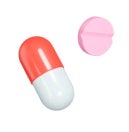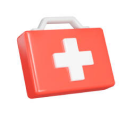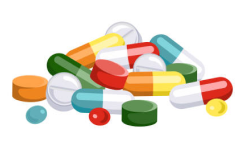Uses
What is SECUKINUMAB for?
Secukinumab belongs to a class of medicines called biologics. Biologics are genetically-engineered proteins. Secukinumab works by blocking the activity of a protein called interleukin (IL) 17A. IL-17A levels are increased in diseases such as psoriasis, psoriatic arthritis and ankylosing spondylitis. Secukinumab blocks IL-17A and helps to reduce the activity of the immune system and the symptoms of the diseases.
It may be used alone or together with other DMARDs.
How should I take or use SECUKINUMAB?
- Secukinumab should be injected as prescribed by the doctor.
- Secukinumab is available as a prefilled (ready-to-use) injection. It is given via injection under the skin (subcutaneously) of your stomach, thigh or upper outer arm. You and your doctor will decide if you should administer Secukinumab yourself. You or your caregiver should receive training on how to inject Secukinumab from your doctor, pharmacist or specialty nurse prior to attempting the administration on your own. Always remember to rotate the injection site.
- The effect of Secukinumab is not seen immediately. It may take several weeks before you observe an improvement in your condition.
- Do not stop using your medication without checking with your healthcare professional. Stopping Secukinumab suddenly may cause the symptoms of your condition to worsen.
What should I do if I forget to take or use SECUKINUMAB?
If you miss a dose, inject it as soon as you remember. Talk to your doctor to discuss when the next dose should be given.
Precaution
What precautions should I take when taking or using SECUKINUMAB?
Inform your healthcare professional if:
- You are allergic to this medication, latex or any of the other ingredients of this medication
-
You are pregnant, planning to become pregnant
- You must use effective contraception while using Secukinumab and for at least 20 weeks after the last dose. Avoid pregnancy while you are taking Secukinumab as the effect in pregnant women is unknown.
-
You are breastfeeding or planning to breastfeed,
- Discuss with your doctor to decide if you should breastfeed or use Secukinumab.
- You should not breastfeed while you are taking Secukinumab and for at least 20 weeks after the last dose.
- You are planning to go for any vaccination.
- You are taking any other medications, including supplements, traditional medications and herbal remedies. Secukinumab may interact with other medications or supplements that you are taking.
-
You have a history of:
- Inflammatory bowel disease
- Hepatitis B or Hepatitis C
- Tuberculosis
Let your doctor or dentist know that you are taking Secukinumab, as it may increase the risk of infection after a surgical procedure.
What food or medication should I avoid when I take or use SECUKINUMAB?
Avoid eating raw, undercooked or half-cooked food.
Secukinumab may interact with other medications or supplements that you are taking. These include:
- Over-the-counter medications
- Nutritional supplements
- Traditional or herbal remedies
Inform the doctor, pharmacist or specialty nurse before starting on a new medication or supplement.
Pneumococcal, influenza (flu) and Hepatitis B vaccinations are safe and may be given if required. Avoid live vaccines such as MMR (measles, mumps and rubella), OPV (oral polio vaccine), yellow fever or BCG (tuberculosis). Discuss with your doctor before receiving any vaccines.
Side Effects
What are some common side effects of SECUKINUMAB?
- Injection site reactions such as swelling, itching or bruising. They usually subside within 3 to 5 days
- Headache
- Sore throat
- Blocked/runny nose
- Diarrhoea
- Cold sores
- White patches in the mouth or on back of throat
Majority of these effects tend to resolve by themselves. Inform your doctor if any side effects persist, if you are unable to tolerate them or the side effects become serious.
Secukinumab may reduce your body’s ability to fight against infection. You should consult a doctor immediately if you develop a fever or feel unwell. Inform the doctor whom you consult that you are taking Secukinumab as the medication may need to be stopped while you are having an infection.
What are some rare but serious side effects that I need to seek medical advice immediately?
The symptoms of a drug allergy include one or more of the following:
- Swollen face/eyes/lips/tongue
- Difficulty in breathing
- Itchy skin rashes over your whole body
Other rare but serious side effects include:
- Signs of infections: fever (temperature exceeding 38°C), chills, cough, painful or bloody urination, feeling very tired or weak.
- Signs of new onset or worsening inflammatory bowel disease: persistent or severe stomach pain, diarrhoea or blood in stools
If you experience any of these symptoms, you should stop your medication and see your doctor immediately.
Handling
How should I store SECUKINUMAB?
Store in the refrigerator at 2 to 8°C. Do not freeze. Keep in original packaging to protect it from light. Keep this medication away from children.
How do I throw away SECUKINUMAB safely?
You may throw this injection away along with the used needles into a metal tin or thick plastic container (eg. detergent bottles). You can also buy a container specially designed to throw sharp items, known as a sharps box, to prevent any injuries due to the needles.
Disclaimers
Please take note that the above is not a complete list of all possible side effects. If you have any concerns about your medication or if you have other side effects that you think are caused by this medication, please consult your doctor or pharmacist.
If you take more than the recommended dose, please seek medical advice immediately. The information provided on this page does not replace information from your healthcare professional. Please consult your healthcare professional for more information.
This article is jointly developed by members of the National Medication Information workgroup. The workgroup consists of cluster partners (National Healthcare Group, National University Health System and SingHealth), community pharmacies (Guardian, Unity and Watsons) and Pharmaceutical Society of Singapore. The content does not reflect drug availability and supply information in pharmacies and healthcare institutions. You are advised to check with the respective institutions for such information.
Last updated on Oct 2022

Need More Medicine?
Use Medicine Order Service on HealthBuddy.

Medicines Reminder
Get reminders and chart progress on HealthBuddy.




















